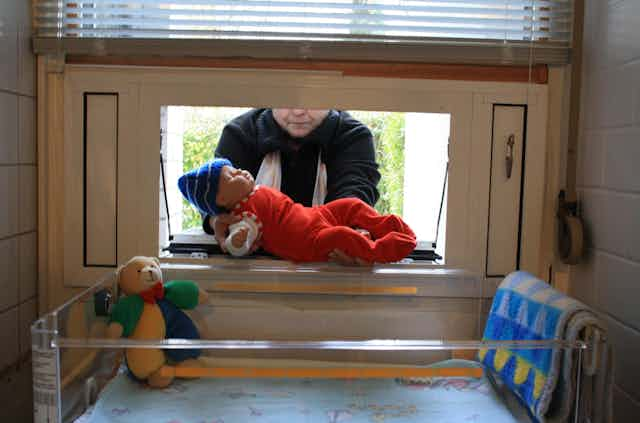Tragedy struck in November when an infant was found dead in a recycling bin in Saskatoon. The death renewed concern that there is no way for women in Saskatchewan to safely and anonymously leave their babies if they feel they can’t care for them.
One proposed solution is a baby hatch, a heated, ventilated cabinet into which people can place their infant and leave. After a very short time, sensors inside trigger an alarm that notifies nurses or others to retrieve the child inside.
In October 2018, Sanctum 1.5, a 10-bed home that supports high-risk and HIV-positive pregnant women and their babies, announced plans for a baby hatch. Within the month, these plans were put on hold by the Ministry of Social Services, which said it wanted a chance to review the plans before proceeding.

After the infant was found in the recycling bin, leadership at Sanctum 1.5 worked to move plans forward with the baby hatch. Executive Director Katelyn Roberts told the Saskatoon Star Phoenix that “the tragedy … demonstrates a real need to push the initiative along in a more efficient way.”
Still, the province, and specifically the Department of Social Services, expresses reticence about moving ahead.
Baby hatches: A place for abandoned babies
Baby hatches can be traced back to foundling wheels built into the walls of convents and hospitals in the Middle Ages through to the late 1800s. These were barrels embedded in an outside wall of the institution — places women could leave a newborn. They turned a wheel to deliver the infant safely to others without venturing inside.

The use of foundling wheels declined over time as laws were introduced that allowed women to give birth to children and to safely and anonymously give them up.
In recent decades, foundling wheels have re-emerged in the form of baby hatches, with iterations around the world. The goal of these new, modern, heated, ventilated hatches is the same as their predecessors: to ensure that those who want to give up their babies safely have a way to do so.
In most of Canada, however, abandoning a baby safely and legally is not an option. There are no “safe haven” laws like those in the United States that allow for parents to “safely surrender” their child in a police station, hospital or fire station.
Instead, Section 218 of the Criminal Code of Canada prohibits abandoning any child under 10 “so that its life is or is likely to be endangered.” As a result, there is discretion in the law about what is considered a danger, and those who would abandon their child are always at risk of prosecution.
There are, however, a few places in the country where children can be left safely and anonymously. Since 2010, three baby hatches have been established — one in Vancouver and two in Edmonton.
Because they are clearly identified as safe places, leaving a child in a baby hatch is one way to circumvent potential legal repercussions. In Vancouver, police have agreed not to pursue parents unless there is evidence that the child “was abused or otherwise endangered.” To date, three babies have been left in Canadian baby hatches.
Women need access to more options
Despite calls for more baby hatches across the country, there has been reluctance to move forward. One objection is that the children involved will not know their family background and health history. This issue is significant enough for the United Nations to have expressed concern that the proliferation of baby hatches around the world may violate human rights agreements about children’s rights to know where they come from.
As both donor-conceived people and adoptees have articulated, people have a right to know their origins.
There are other concerns. Critics have suggested, for example, that women might be coerced into leaving a child in a baby hatch against their will, or conversely, that women may give up a child without the knowledge of a father who may be willing or able to raise the child.

Others suggest there is no evidence, or at least no evidence yet, that baby hatches do anything to reduce infanticide or the abandonment of children in precarious circumstances.
While these critics raise important objections, it’s unclear that their concerns are more important or more pressing than giving women the capacity to give up their child safely if they need to do so.
Further, there are ways to mitigate some of these issues and support women using baby hatches in their decision-making. In Germany, for example, there is an eight-week period where a woman can change her mind and come back to retrieve her child.

Baby hatches aren’t a perfect solution. They are no substitution for affordable housing, readily available mental health services, safe and accessible abortion, publicly funded childcare, and a minimum guaranteed income (among other social programs and services) that make it possible for more people to choose whether and when to raise children.
And there may always be some people, no matter what provisions are in place, who will abandon their baby in a dumpster, a stairwell or a recycling bin.
Still, without safe haven laws or other sites where babies can safely be left without the risk of legal repercussions, baby hatches make a critical, potentially lifesaving option available to those faced with an impossible choice.
In Saskatoon, as elsewhere, baby hatches might just save both mother and child.

